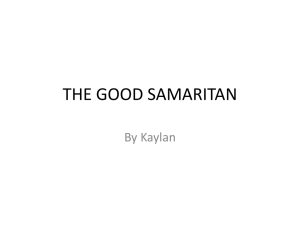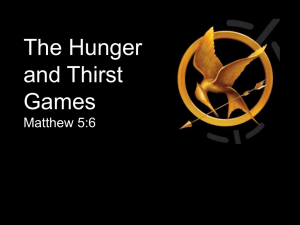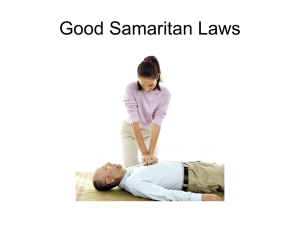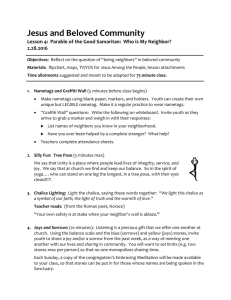**But what would happen if allowed ourselves to change the way we
advertisement
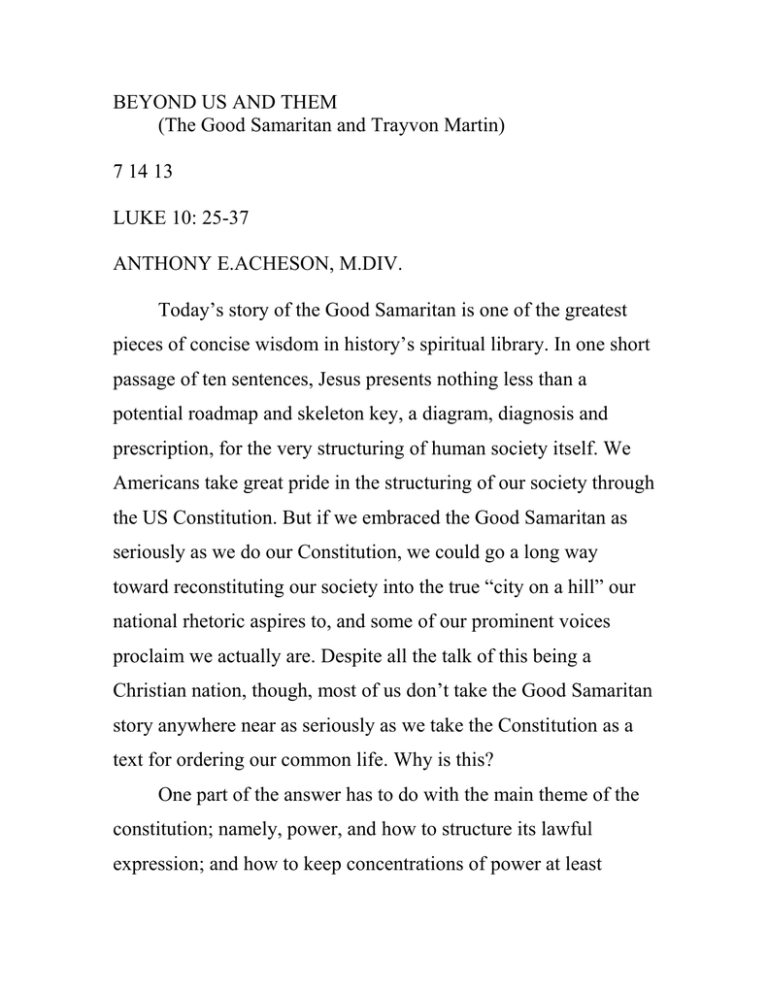
BEYOND US AND THEM (The Good Samaritan and Trayvon Martin) 7 14 13 LUKE 10: 25-37 ANTHONY E.ACHESON, M.DIV. Today’s story of the Good Samaritan is one of the greatest pieces of concise wisdom in history’s spiritual library. In one short passage of ten sentences, Jesus presents nothing less than a potential roadmap and skeleton key, a diagram, diagnosis and prescription, for the very structuring of human society itself. We Americans take great pride in the structuring of our society through the US Constitution. But if we embraced the Good Samaritan as seriously as we do our Constitution, we could go a long way toward reconstituting our society into the true “city on a hill” our national rhetoric aspires to, and some of our prominent voices proclaim we actually are. Despite all the talk of this being a Christian nation, though, most of us don’t take the Good Samaritan story anywhere near as seriously as we take the Constitution as a text for ordering our common life. Why is this? One part of the answer has to do with the main theme of the constitution; namely, power, and how to structure its lawful expression; and how to keep concentrations of power at least somewhat diffused and balanced. Since we don’t usually think of the Good Samaritan as a story about power, we don’t usually have any reason to think about it in relation to – or in comparison to – the Constitution. In a certain sense, though, and one much less obvious, the Good Samaritan can and should in fact be seen as a story that is also about power. But in contrast to the Constitution, the emphasis of this great parable of Jesus lies not in gaining, exercising or sharing power, but rather in the importance and centrality of being willing and able to share, and even surrender power – or, at least, to surrender power in the forms that it is most usually sought and exercised in ordinary social, economic and political life. I recognize that it might seem strange to interpret the Good Samaritan in terms of its implications about power. We usually think of this as a story about compassion. It is that, to be sure. But what is involved here is more than a simple admonition to act more lovingly. More subtly than that, the point of this parable is based on a second idea: that embracing love, and truly doing the work of love, involves transitioning ourselves into a fundamentally different relationship to power from what our culture habitually conditions us toward. There is an implication in Jesus’ story that being able to live lives structured around love and compassion requires significant changes within ourselves. And among those changes is acquiring the willingness – and the ability -- to give up our habitual patterns of seeking advantage over other people through exercising power, control and domination over them. This is why I would say that a major theme of the Good Samaritan does indeed have to do with power insofar as it calls us to the surrender of those forms of power that bring advantage to ourselves through ways of living that cause, or allow, the infliction of hurt and harm on others. Let me be more specific about how the Good Samaritan speaks to this. One of the most common forms of power we humans frequently seek out is the power of collective muscle, the power that comes from connecting ourselves to larger social entities that are strong, and act that strongly on our behalf. This psychological striving is an important dynamic behind our deep desire to be part of a social in-group, to be part of an an “us.” There is nothing wrong with being part of advantageous social groupings. The human psyche, to be sure, has an inborn drive to be part of something larger than itself. That need is met in several different ways. Just as it is met by being in our mothers’ arms (and can be met by resting in the Everlasting Arms) one major way we try to meet that need to be part of something larger is to be part of powerful groups. Our psyche looks to these larger collective affiliations as vehicles that can protect us and provide for us. As a consequence we humans like very much to be part of larger, powerful things. We like to be part of powerful nations. We like to be part of powerful tribes or clans, religions or empires, sects and civilizations. We like to be part of powerful corporations or unions. We want very much to be part of an economic class that has the clout to cushion our lives. This desire to be associated with or identified with a powerful group can be as benign as feeling part of Red Sox Nation, or as destructive as taking part in National Socialism. It can be as benign as taking advantage of group buying power through Groupon or Costco, or as damaging as consenting to an economic system in which large clothing companies have their shirts and jeans made in hell-hole factories like the one that collapsed in Bangladesh on April 24 of this year, killing more than 600 people. But even though identifying with larger groups is not an inherently negative phenomenon, I would argue nonetheless that the overwhelming majority of human wrongdoing; the overwhelming majority of the hurt and harm we humans in fact inflict; the overwhelming majority of the sin that we human beings commit, to use Biblical language, is the wrongdoing which we do through the groups we are part of. Most of the evil men and women do is done through collectives. The bulk of the cruelty and killing, oppression and needless impoverishment that takes place in the world is brought to pass through these groups and collectives and, very importantly, through the willing consent of the individuals who comprise them and who identity with them. Most social groupings, in other words, have a shadow side. And it is one of our most major moral responsibilities, first, to see and acknowledge this; and, second, to understand some of the pathways through which this phenomenon works. Specifically we need to see the following contrast: that whereas most people won’t and don’t do terrible things as individuals, a great many of us as individuals are more than happy to let our nation, army or intelligence services; our religions, tribes, genders or economic classes inflict major hurt and harm upon large numbers of people who are not in our own home group (like Samaritans) who are therefore not one of “us,” but one of “them.” There is an important feature of this story in Luke 10 that is often overlooked. The text tells us that this conversation about loving our neighbor takes place between Jesus and a lawyer. In approaching this parable we are wise to ask:who are lawyers; and why is a lawyer at the center of this teaching tale? Lawyers are people who deal with the way society is legally ordered and structured. The fact that the story is framed as a teaching offered in response to a lawyer’s question how people should be treated clearly that the parable aims to answer one of the most basic of questions: by what rules is society best structured? Around what principles should a society be built? And when we enact specific laws, and evaluate social practices, what major themes should be the guiding lights for how the human society conducts and orders its business? Consider the way Jesus responds to the lawyer’s question, “who is my neighbor?” The answer Jesus gives has two parts. There is a positive part that describes what to do, what should be done. And then there is a negative part about what not to do, what to avoid. The positive part is clear enough: be compassionate to those in need. Today I want to to focus mostly on the second, negative part of the story, the “what not to do” aspect. It’s relatively easy to say, “Be compassionate,” but it’s much harder to be specific about what that means, and to translate the love-principle into a tangible result. Doing that requires taking on the second, negative, side of the equation which has to do with challenging and interrupting what people have become accustomed to doing, but may need to stop doing. The traditional, Biblical term for this is repentance. When Christianity advises and counsels us to repent, it is urging us to be willing to, first, identify negative behaviors that have become entrenched in us, and, second, let go of repeating them. And that is what the second half of Jesus’ story does. He starts by stating the positive side, “Love God, and love your neighbor.” But he doesn’t stop there. He goes on to say, by implication, “If you are serious about loving your neighbor and structuring your life around compassion, here are some things you will need to stop doing.” If we want to respond to Christ’s teachings, in other words, there are not only truths we need to learn; there are also patterns we need to unlearn. And in this Good Samaritan story he gets to the nub of one behavior specifically that needs to be unlearned: our deeply entrenched human tendency toward putting up lines of demarcation between those who are inside our own social networks, and those who are outside them. We need to unlearn seeing our fellow humans in terms of who is one of “us” and who is one of “them.” We need to unlearn looking at another person – any other human being – and viewing them the way many Jews in Jesus’ day viewed Samaritans: as suspect and dangerous, as inferior and degenerate, as less than worthy of our affection and respect. We live in a time in which there are great cultural forces that not only are divisive, but also pressure us into becoming divisive ourselves. There are numerous examples we could cite of this pressure. For today I want to close by citing just one example, which came to my attention in a headline of this morning’s New York Times. It describe the verdict that came down yesterday in Florida in the Trayvon Martin murder case. You may remember that Trayvon Martin was an unarmed, black teenager wearing a hoodie who was shot to death on February 26 of last year in Florida while on a quick run to buy some candy. Yesterday, the defendant in that case was acquitted of that killing. The Times reports that the jury accepted his argument of self-defense. It accepted his attorney’s assertion that he was justified in using lethal force because of his fear of great bodily harm. As we consider today’s theme of how people from within social groups and identities, I want to invite you to engage in a mind-experiment that has to do with imagining what might have happened if the major players in that Florida drama had had substantially different group affiliations. This mind-experiment has two parts to it. First, imagine that the man walking down the street to a convenience store in that Florida town on February 26, 2012 had been a white, middle-class, middle-aged man wearing a suit and tie and carrying a briefcase. Do you think it is likely that someone who was active in a Citizen’s Watch program in that neighborhood would have felt that he or his family were in danger from such a man who had that kind of white, middle class appearance? I strongly doubt it. What is much more likely is that a caucasian, establishment-looking man walking through that part of town would have been barely noticed, let alone accosted, by a zealous Citizen’s Watch volunteer. In this first scenario, it is highly likely no one would have been attacked, and no one would have been killed. But Trayvon Martin was killed, and the facts of the case suggest strongly that he was initially viewed with suspicion by the defendant because of the way he looked. He was young. He was black. He was male. He wore casual clothes that did not suggest affluence. Let’s turn to the second part of our mind-experiment. This time suppose that a shooting had in fact taken place on that same street, but this time the white, well-dressed middle-aged man we imagined a moment ago was the victim who had been shot and killed. And let’s imagine again that person accused of the shooting had been a teen-aged, black male, wearing a hoodie. How likely do think it might be that an American jury – a southern American jury -- would have handed down an acquittal under those circumstances? How likely do you think it is that such a jury would have decided that such a shooting – of a white middle-aged guy by a black teenage male -- would have sprung from a justified fear of great bodily harm, as yesterday’s jury apparently did? I think the chances are substantially high that a case like, with a white establishment victim and a young black man, would have led to a very different result and a guilty verdict. Why? Because it is a fact of our condition – and ongoing dilemma of the human mind – that the decisions that many human beings make in many emotionally charged cases is determined by their predominant group identifications. And in our culture there is a substantial and historically well-document willingness by the mainly white middle-class culture to be more than willing to inflict hurt and harm on young black males, but to protect middle-class and middle aged white men and give them the benefit of the doubt. Was that dynamic was at work in the Trayvon Martin case? I cannot, of course, be absolutely sure about any single case, and want to be honest about that ambiguity. But I am absolutely sure that that kind of dynamic has happened and does continue to happen in our culture with disheartening frequency. It happens continually. And the reason it does happen is that people who identify with the majority, established white middle class in-group in our society have a long-standing, historically habituated tendency to regard young black males as potentially dangerous and expendable. In white middle-class America, young, black seemingly swaggering males are a form of Samaritan. Just as many of Jesus’ co-religionists expected no good to come from a Samaritan, there is a deep seam in the American mind that expects no good from young, black men. There are many among us indeed who tend to see young black males not at all as one of “us” to be protected, but very much as one of “them” to be suspected; to see them as “one of those Samaritans”: dangerous, lesser and expendable. I offer that today as one example of how identification with larger social groups whose members feel like “us” can give us an entitled sense of permission to do or consent to insidious, terrible acts against people who belong to other groupings than ours; and to do or consent to acts that we would be highly unlikely to do as mere individuals, or against someone who looks like “one of us”. I look forward to taking up some of these themes again with you the next time we meet.
